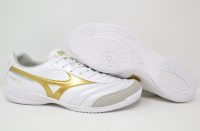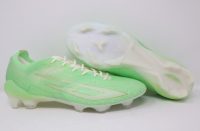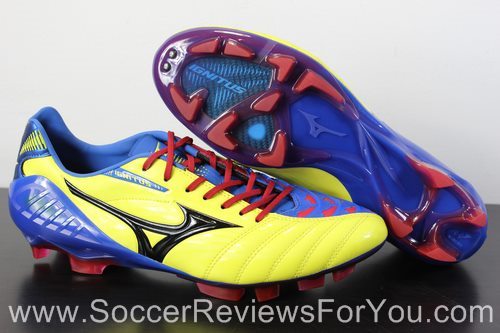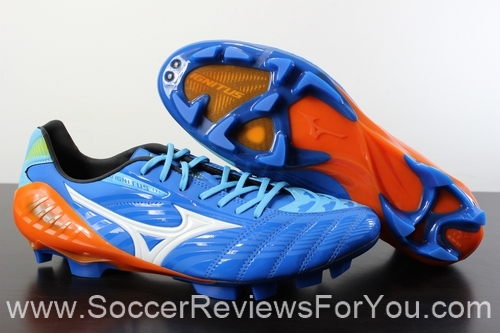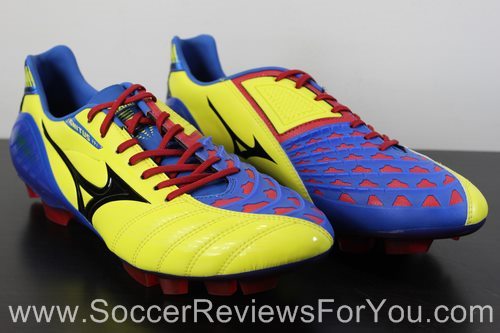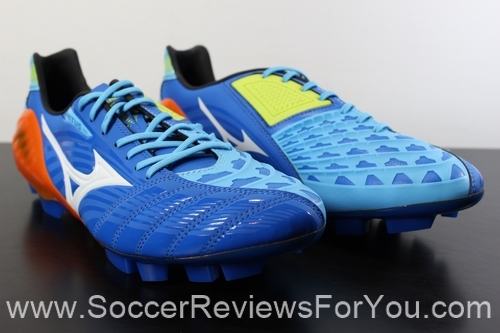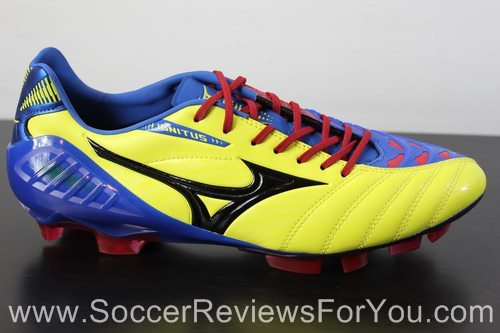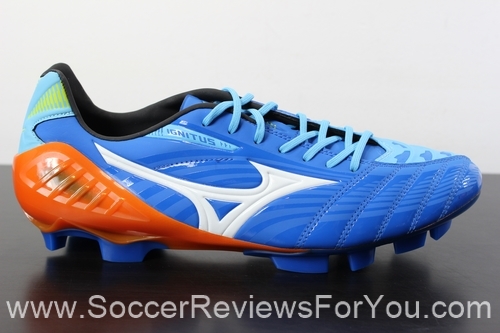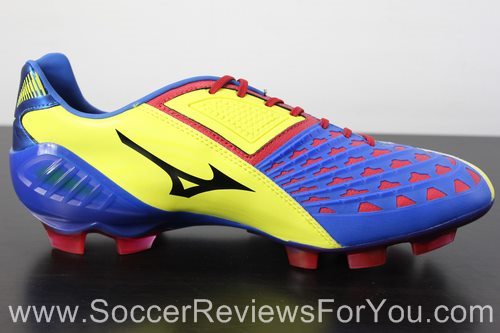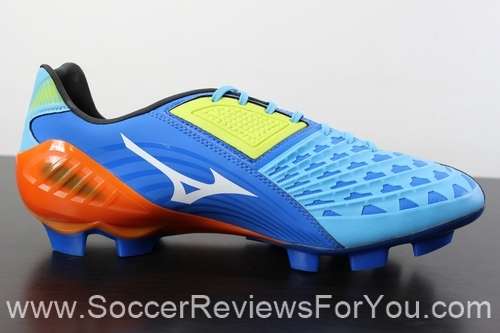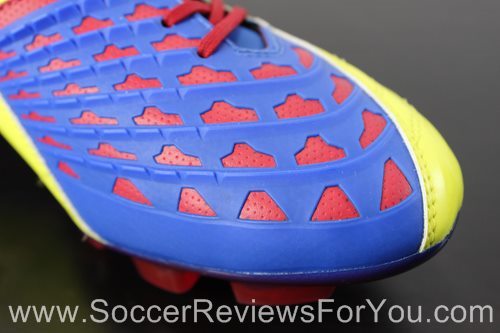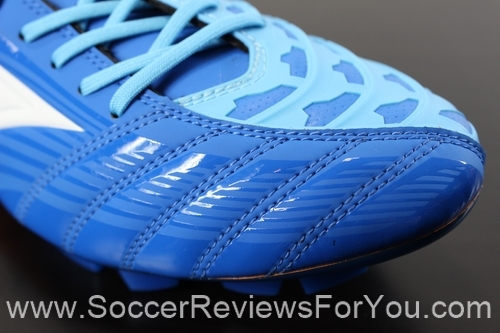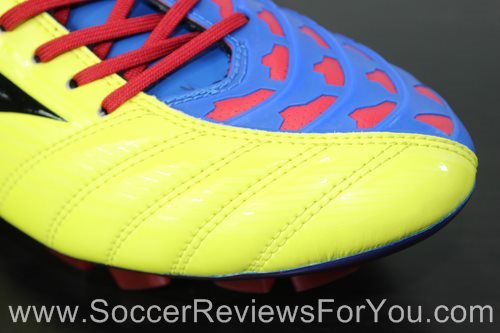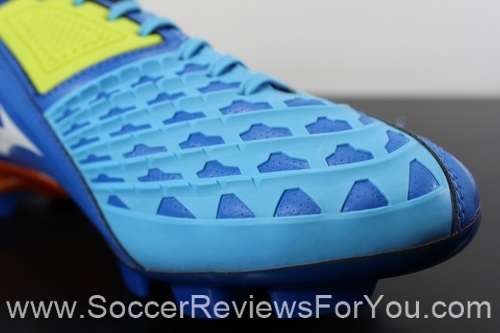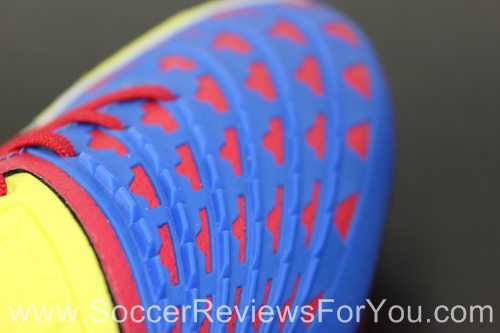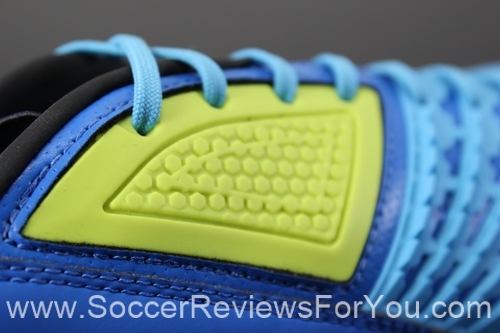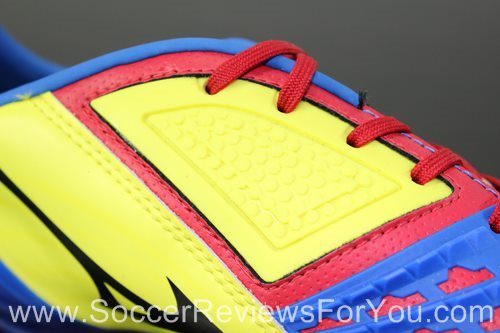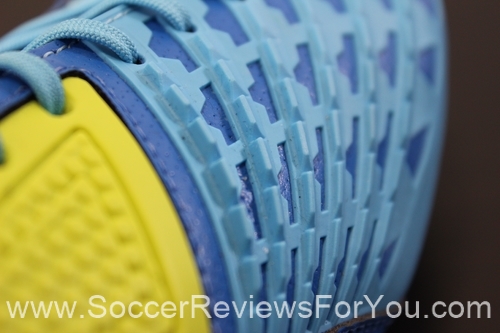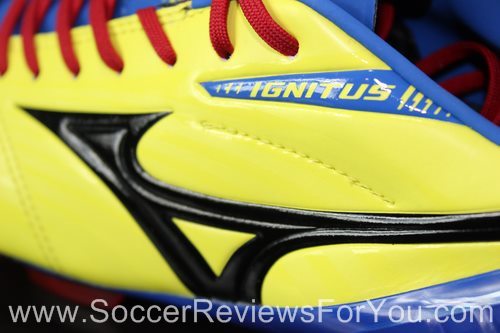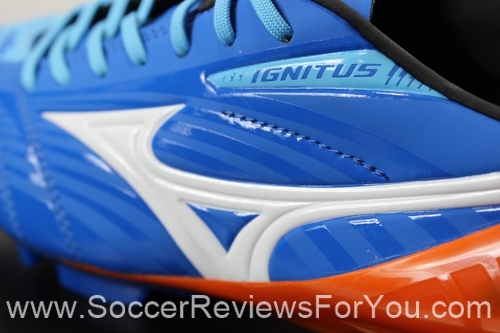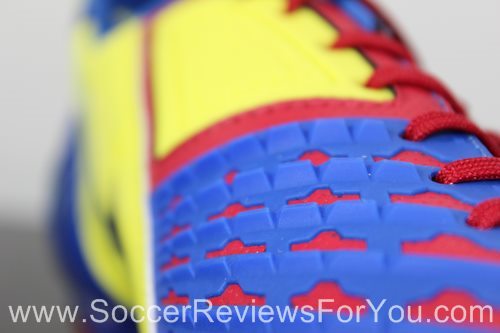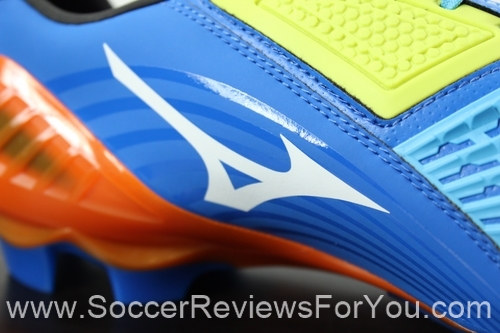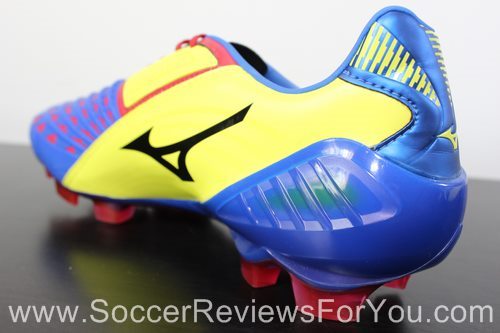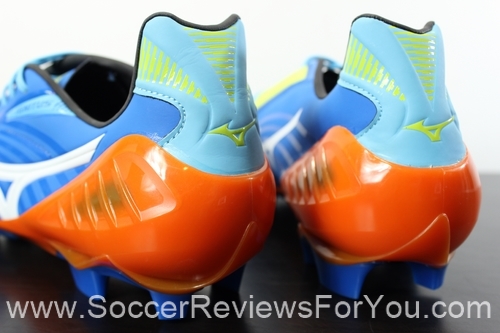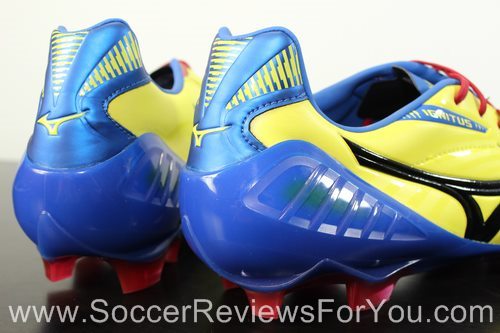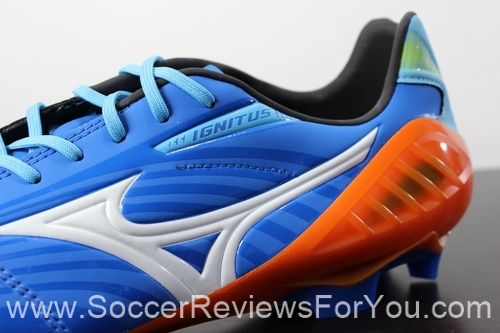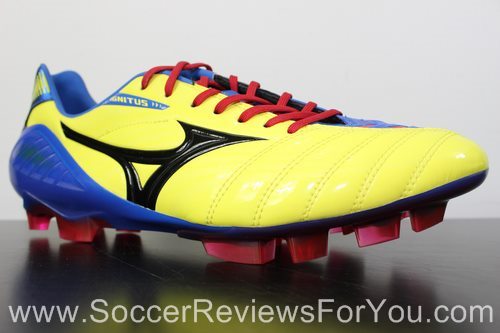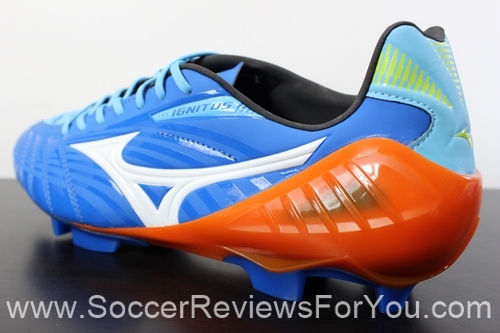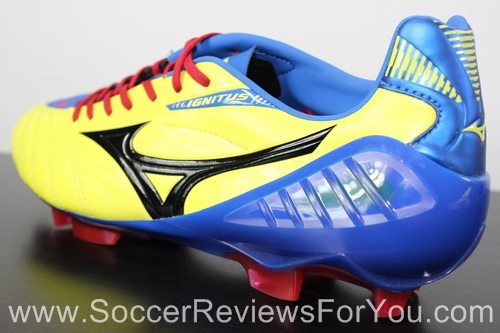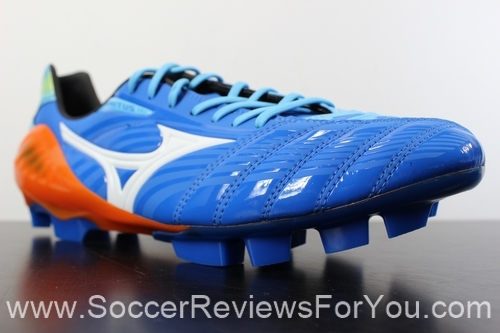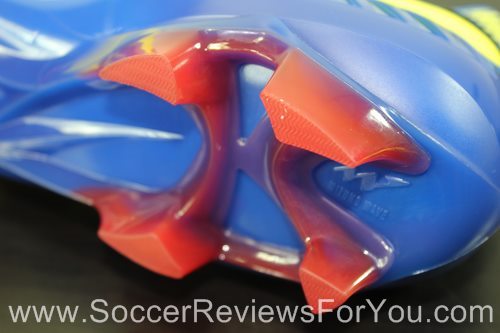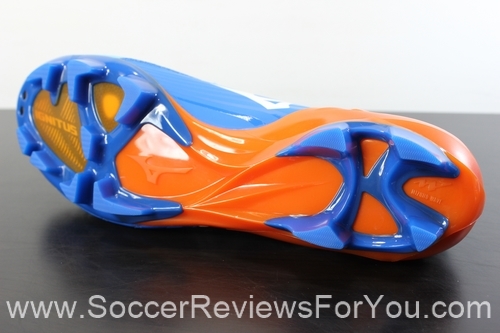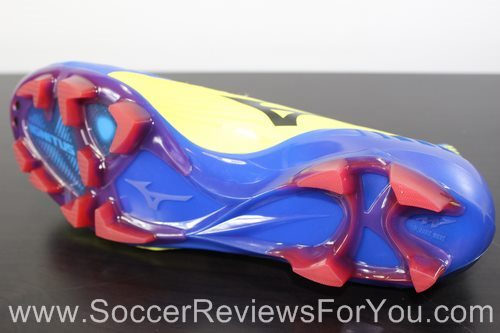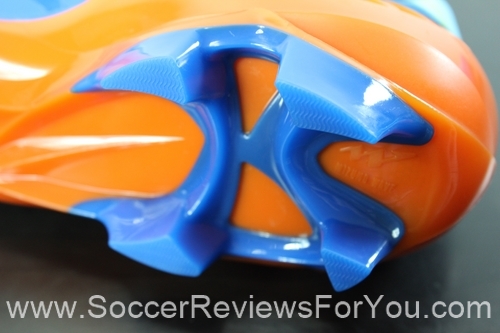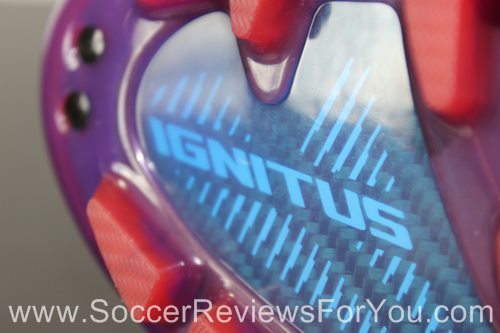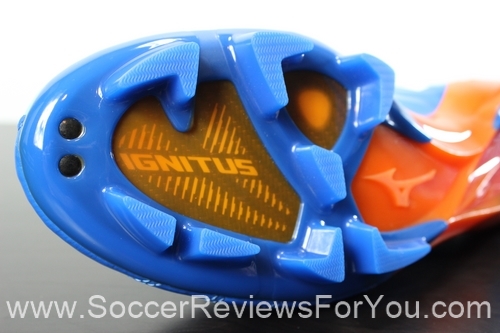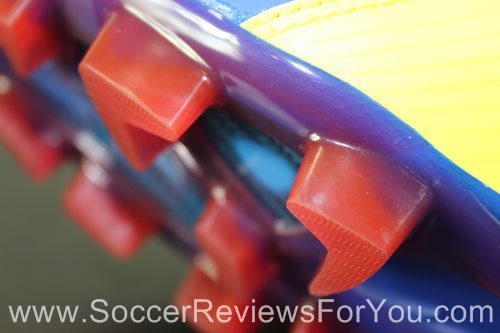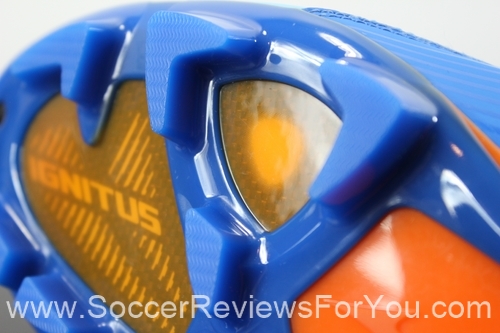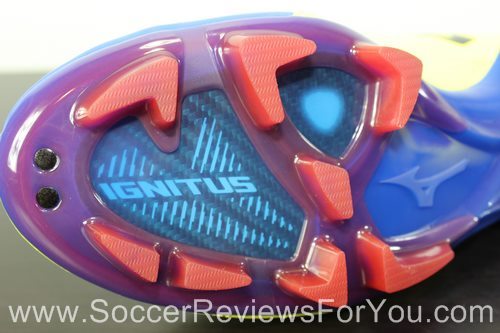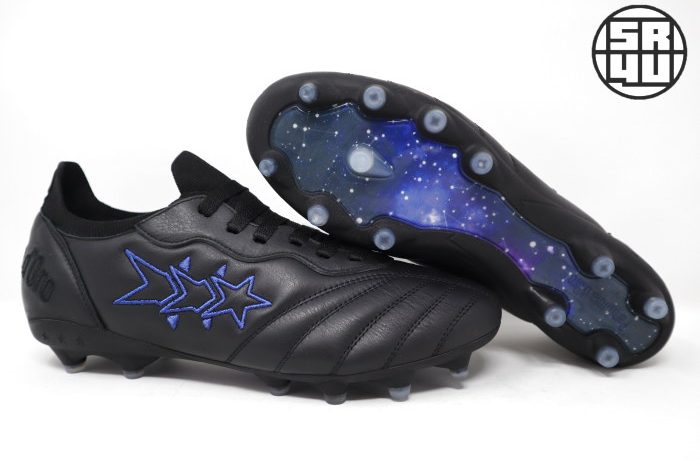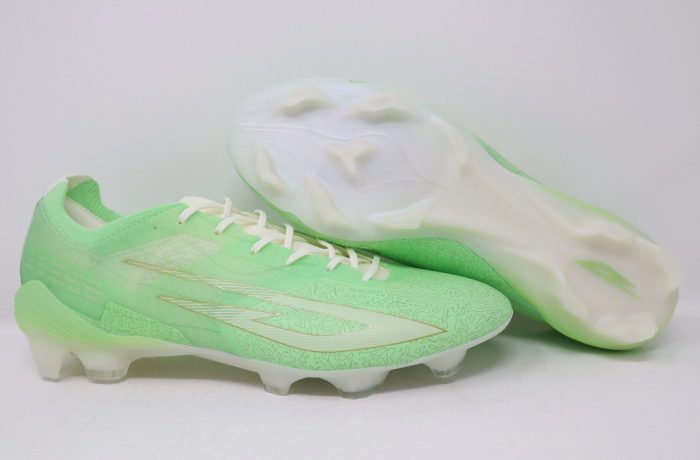Mizuno Wave Ignitus 3 Review
Coming from the Wave Ignitus 1 and 2, there are two significant changes that you’ll notice immediately when you first try on the Wave Ignitus 3, and that is the synthetic upper and slimmer profile of the boot. Both of these changes really threw me off at first, as it makes the boot feel completely different in comparison to the first two models. Coming from the kangaroo leather upper of past Wave Ignitus models, I found the new synthetic upper to be quite simply, not as good, but by no means bad either. Mizuno claims to have gone with a synthetic upper to shave down the weight of the boot, which they’ve successfully done, but from what I can tell, the main reason for the switch is down to the redesigned striking elements that just wouldn’t work with a leather upper. The synthetic material is slightly padded, and is certainly more along the lines of leather-like in terms of how it feels on the ball, but lacks that premium feel that I was expecting.
From right out of the box, I found the boot to feel quite snug, and just a lot less bulky than the two previous models. Break-in time is essential before this boot starts to feel truly comfortable, as the upper is quite stiff from brand new. I found that the WI3 needed about 3 to 4 hours of wear-time before it really started to form to my feet, making for a more comfortable feel overall. I did have some minor blistering across the top of second toe, on both feet by the way, due to the transitional stitching between the main striking element and the upper. While the issue was minor, it’s still something worth noting. Once the upper softens up, the WI3 is a very comfortable boot.
One of reasons why Mizuno is such a great company is because they really consider everything when designing a boot, from comfort to performance. The Wave Ignitus 3 feels supportive, yet lightweight, which is a tough combination to find. The deep fit allows your heel to be locked securely in place, while still maintaining plenty of mobility at the ankle. This is achieved by having a slightly taller than average Achilles guard, a lower cut at the ankle, and a relatively large external plastic heel counter.
One of my personal favorite new additions is the redesigned soleplate and stud pattern. The stud pattern itself was designed with three key elements in mind; traction, stud pressure and planting for a shot. You’ll notice that the stud pattern is made up of all blades, varying in shape as well as in size. What’s great is that each stud spans a larger than average surface area, allowing for great stability, as well as dramatically cutting down on stud pressure. The stud pattern in combination with the flexible soleplate makes for a smooth and comfortable running experience.
The fit of the boot is arguably improved over past Wave Ignitus models, offering a fit that is much less bulky in comparison, but at the same time still accommodating for most foot types. The off-centered lacing system runs deep into the forefoot allowing for a very secure feel all the way through when you pull the laces tight. There is a decent amount of width through the mid-foot and forefoot, while the heel and toe box area tends to feel a little more snug. The Wave Ignitus 3 is suitable for pretty much all foot types, just as long as you don’t have excessively wide feet. It’s also worth noting that the synthetic upper will stretch a little, but for the most part, the way it fits from right out of the box is roughly the way is will fit after being broken-in.
In terms of sizing, I wore my usual size 9US for review, and the fit was very snug, especially from right out of the box. The reason for the snug fit is mainly because the overall shape of the WI3 is the same as previous models, but the toe box is a lot less bulky this time around, making for a slightly more snug fit length wise. After some break-in time, I found myself to be perfectly comfortable in my true size 9US. So, if you prefer a very snug fit, stay true to size, but if prefer to have a little bit of breathing room in your boots, than you can safely go half a size up.
Weight
The Mizuno Wave Ignitus 3, in a size 9US, weighs in at 8.2oz, which is about an ounce less than the WI2. As mentioned earlier, the main justification expressed by Mizuno for going with a Synthetic upper was to shave weight, which obviously they’ve done successfully. While 8.2oz isn’t anything ground breaking, when you consider the style of boot that is the WI3, the only other shoe that really compares would be the Adidas Predator LZ 2. When it comes to lightweight options that still offer a supportive and solid feel overall, the WI3 is arguably the best options available.
Traction
The redesigned stud pattern, while it appears very different, actually performs very similarly to the first two WI models. The longer than average bladed studs span the outside edges of both the lateral and medial sides of the forefoot, allowing for plenty of traction when pushing off for a sprint. The larger than average surface area of the studs also makes for a very stable feel beneath your feet when running, stopping and starting.
One of the most unique design aspects of the all new WI3 stud pattern is the placement of the heel studs. The concept is all about the boot providing maximum traction when planting your foot for a strike. So, what Mizuno has done, is make the first stud that hits the ground much more narrow than the rest of the studs, allowing that stud to easily penetrate the ground, locking your heel in place and hopefully helping to prevent any kind of slippage. The concept works very well, and overall, the WI3 provides one of the most stable feels when striking the ball that you can get. Once your foot is planted for a strike, it’s highly unlikely that your foot is going to slip.
Touch
Coming from the first two Wave Ignitus models, the major change that almost everyone seems to be concerned with is the synthetic upper. In all honesty, the synthetic upper of the WI3 is alright, but it just doesn’t come across as premium, especially if compared to some of the synthetics currently on offer from brands like Nike and Adidas. I’ll be the first to say that I wish the WI3 was made from kangaroo leather, but with that being said, I don’t think that the design of the WI3 would actually benefit from having a leather upper.
As mentioned earlier, the main difference between the first two Wave Ignitus models and the WI3, is the less bulky feel, and that all comes down to the synthetic upper and redesigned striking elements. The upper itself features a very smooth, slightly shiny finish that provides very little extra grip on the ball, but this doesn’t really sum up the overall feel of the WI3. The main reason why I don’t feel as if a leather upper is necessary for the WI3, is because the majority of your touches on the ball are going to be made across the very large, rubber striking element, which spans nearly the entire instep, as well as the top of the foot. This design reminds me very much of the now discontinued Nike T90 Laser 4, but with a much less bulky feel.
The lower part of the striking elements is relatively smooth, with small breaks throughout, exposing a perforated synthetic leather material. This allows for some additional grip on the ball, while still allowing the ball to slide freely across the upper when dribbling, making for a much more natural feel than you might expect, or get from other similarly designed shoes. I’m always the first to complain about having too much grip on the ball when dribbling, but this simply was not an issue that I had with the WI3. Again, I think that the lack of bulk to the striking element plays a part in allowing you to better manage the extra grip of the rubber while still being able to maintain as much feel for the ball as possible. Since the boot has a tighter overall fit, and the striking element is essentially fused directly to the upper, you get that little bit of extra cushion upon impact, without making the boot feel too bulky.
Shooting
The Wave Ignitus series is primarily designed around striking the ball, so it shouldn’t be too surprising that this is also the main highlight of the boot, at least for me. There are three parts that make up the striking element as a whole, all of which are designed for different types of strikes.
The Mukaiten panel, which means “No Spin”, is a textured rubber pad, positioned higher up the foot, near the ankle, in line with where you would strike the ball to achieve the no spin or knuckle effect. While the Mukaiten panel does work to a certain extent, it isn’t necessarily magic, as some make it out to be. The Mukaiten panel is essentially a piece of pliable rubber, that is different from previous versions in that it’s slightly larger and features a dimpled texturing, but for the most, the feel is nearly identical. If you strike the ball correctly, the Mukaiten panel will grip the ball a little more efficiently than your average soccer cleat would, allowing you to achieve the knuckle ball effect a little more easily, not better. At the end of the day, it is a slightly gimmicky element, but if knuckle balls are your thing, than you may enjoy this particular feature.
The next part of the striking element is called Yokokaiten, meaning “Side Spin”, which is the smooth rubber portion of the main striking element. It’s positioned right at the base of the soleplate in the forefoot, and is designed to provide additional grip on the ball when hitting a curling shot. Again, there’s nothing ground breaking here, but the striking element is definitely effective in providing additional grip on the ball. What’s great about this particular striking element is that you get that additional grip, while still maintaining a very responsive, close to the foot feel.
The final part of the striking element is called Tatekaiten, meaning “Top Spin”. This part of the striking element is made up of flared out, slightly harder rubber fins spanning the main portion of the foot that would normally be used when driving a shot on goal. These fins provide a little bit of additional grip, but mainly they just make for a more responsive feel when laying into the ball.
The three part striking element in combination with the supportive yet solid soleplate, makes for a striking experience that is hard to come by nowadays. The major difference coming from the WI2 to the WI3 is the overall more responsive feel, as well as the slight amount of additional grip on the ball. The argument could be made that the feel is similar to that of the Predator LZ 2, but personally I feel as if the Wave Ignitus 3 is a little more refined.
Protection
The WI3 is above average when it comes to protection. While the upper is synthetic, it isn’t particularly soft, and has a more rugged feel about it, so should you get stepped on, it will provide some decent protection. The striking element also provides some decent protection should you take a blow to the foot. The larger than average external plastic heel counter covers nearly the entire rear of the boot, keeping you safe against kicks to the back. The only weak spot on the upper is the thin synthetic tongue, but due to the nature of the lacing system, once you pull the laces tight, there isn’t much of that tongue being left exposed. If protection is a concern for you, than the WI3 is definitely a solid option, especially considering that it doesn’t have a particularly bulky feel.
Durability
Mizuno has a reputation for putting out high quality, long lasting boots, and the Wave Ignitus 3 is no different. While the synthetic upper may be viewed as a negative when it comes to feel, it’s definitely a positive when you’re talking durability. Sole separation is not a concern, and it’s always nice to see that the soleplate is riveted to the upper right at the toe. After over 20 hours of playing time, nothing has jumped out at me as a potential durability concern, and for the most part, the boot still looks relatively new. The WI3 is a boot that should easily get you through a season’s worth of play, if not several seasons, depending on the person.
Keep in mind that the firm ground version of the Wave Ignitus 3, or any FG shoe for that matter, is designed for use on firm, natural grass playing surfaces. Using any FG stud pattern on artificial grass will surely have a significant impact on the longevity of the boot.
The Verdict
The Wave Ignitus 3 is a great boot, but I wouldn’t necessarily call it an improvement, rather than a change. The WI3 is Mizuno’s response to the current trend of soccer cleats, going towards a more lightweight, streamlined feel, and they’ve definitely achieved that with this new design. While they have tweaked the Wave Ignitus in a way that is arguably more “mainstream”, it is still a standalone in comparison to everything else out there. You get an awesome striking element, a great fit, and a unique stud pattern, all in a package that weighs in right at the 8oz mark! I can’t say that the Wave Ignitus 3 is all that I was hoping for, but I still thoroughly enjoyed the boot and would definitely put it up there as one of the best releases of 2013.
| Comfort/Fit | 9 out of 10 |
| Weight | 9 out of 10 |
| Traction | 9 out of 10 |
| Touch | 8 out of 10 |
| Shooting | 10 out of 10 |
| Protection | 8 out of 10 |
| Durability | 10 out of 10 |
| FINAL SCORE | 63 out of 70 or 90% |



